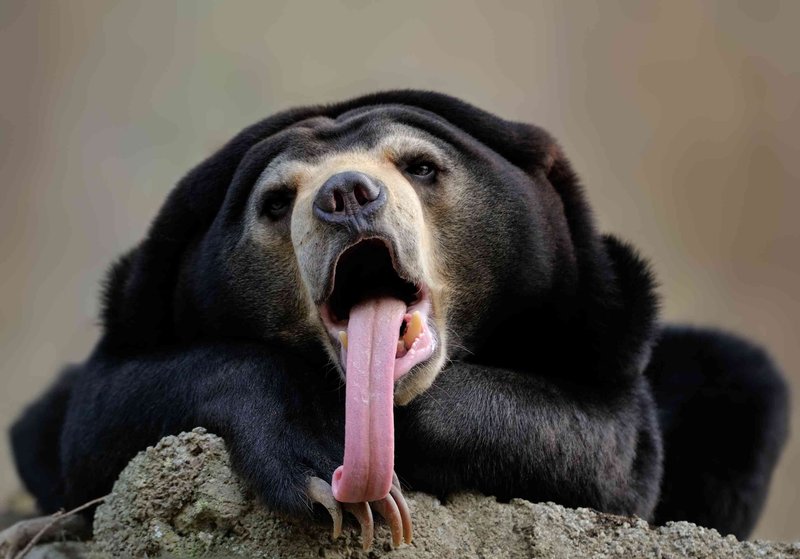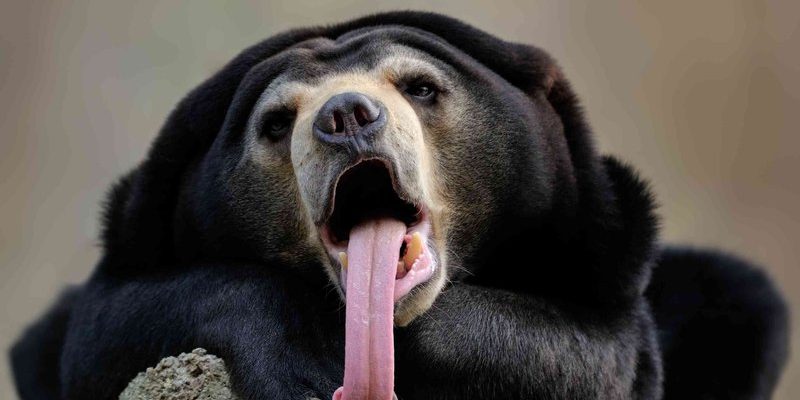
Sun bears live primarily in the tropical forests of Southeast Asia. These bears are often overlooked, yet they play a crucial role in their ecosystems. Their cute, almost puppy-like faces can make anyone smile, but there’s so much more to these bears than just their adorable appearance. Let’s dive into ten fascinating facts that will change the way you think about sun bears.
1. The Smallest Bear Species
Sun bears are officially recognized as the smallest bear species in the world. Typically, they grow to about 4 to 5.5 feet long and weigh between 60 to 150 pounds. That’s roughly the size of a large dog! With their compact build, they are perfectly adapted for life in the trees, where they can easily navigate branches in search of food. Imagine a bear that’s more agile than you’d expect—it’s quite a sight!
Their small size doesn’t mean they lack personality. In fact, sun bears are playful and curious, often engaging in fun antics as they explore their environment. When you see one climbing or swinging from branches, you might think you’re watching a playful puppy rather than a bear.
2. Unique Markings and Features
One of the most striking features of sun bears is their distinctive golden or white chest mark, which resembles a rising sun—hence their name! This mark isn’t just for show; it helps with communication among bears. Think of it as a bear’s personal logo that says, “Hey, I’m unique!”
Their short, sleek fur makes them look like they’ve just come out of a shampoo commercial. But the real magic lies in their long tongues, which can reach up to 10 inches! These tongues are specially designed for extracting honey from beehives, making them experts in a sweet treat. Imagine being able to reach into a sticky hive without a care—now that’s talent!
3. A Diet of Fruits and Insects
Sun bears are omnivores, which means they eat a little bit of everything. Their diet mainly consists of fruits, insects, and small animals. If you ever find yourself in their habitat during fruit season, you might be amazed at how they feast on ripe figs or durians.
These bears have sharp claws that help them dig into tree trunks to find insects like termites and ants. It’s like they have their own built-in Swiss Army knife! Honestly, you might find yourself rooting for them as they tackle their next meal. You might be wondering how they manage their diet—well, they spend a significant part of their day foraging, showcasing their keen sense of smell.
4. Amazing Climbers
Sun bears are incredible climbers. Their long claws and strong limbs enable them to navigate the treetops with ease. Unlike most bears, who prefer to stay on the ground, sun bears feel right at home up high. You could say they’re the “tree-huggers” of the bear family!
This ability to climb plays a crucial role in their survival. Not only do they forage for food in the trees, but they also escape predators by retreating to higher ground. In a world where danger lurks at every corner, being able to scamper up a tree can be a lifesaver.
5. Solitary Creatures
Unlike some other bear species that may roam in groups, sun bears are primarily solitary. They enjoy their own company, often seen wandering alone in the forest. This can make them a little tricky to spot in the wild, as they prefer to blend into their surroundings and go about their business quietly.
However, when mating season rolls around, these bears do interact with one another. Males will often roam larger territories in search of females. Imagine a bear date under the stars—sounds charming, doesn’t it? Still, they generally thrive on their own, showcasing the beauty of independence in the animal kingdom.
6. Thick Fur for Tropical Life
You might think that a bear’s fur would be thick and warm, but sun bears are the exception. They have short, sleek fur that helps them cope with the hot and humid climate of their tropical habitat. It’s like they’ve got the perfect outfit for a summer day!
Yet, their fur does more than just keep them cool. It offers some protection from the harsh sun, helping to prevent sunburn. The unique fur texture not only aids in temperature regulation but also gives them the flexibility they need for climbing and foraging.
7. Importance in Ecosystems
Sun bears play a critical role in their ecosystems. As they forage for fruits and insects, they help maintain the balance of their habitats. By spreading seeds through their droppings, they contribute to the growth of new plants. Think of them as little gardeners of the forest, planting future trees without even knowing it!
Moreover, their hunting of insects helps control populations, keeping the ecosystem healthy. It’s easy to overlook the small players in nature, but every creature, including the sun bear, has its part to play in the grand symphony of life.
8. Conservation Challenges
Unfortunately, sun bears face several threats that put them at risk. Habitat loss due to deforestation and poaching have led to a decline in their population. You might be surprised to learn that despite their important role in the ecosystem, sun bears are considered vulnerable.
Conservation efforts are underway, but they need all the help they can get. Organizations are working hard to protect their habitats and raise awareness about the dangers these bears face. Every little bit helps, whether it’s supporting conservation programs or simply spreading the word about these incredible creatures.
9. Unique Communication
Sun bears have some interesting ways of communicating with each other. They can make a variety of sounds, including growls, roars, and even squeaks! When you hear a bear making noise, it’s often trying to convey something important—like warning others or expressing excitement.
Interestingly, they also use body language to communicate. A bear might rise on its hind legs to get a better view or to assert dominance. It’s a fascinating dance of signals that keeps their interactions dynamic and engaged.
10. The Future of Sun Bears
The future of sun bears can look brighter with continued conservation efforts and increased awareness. As more people learn about these fascinating animals, we can work together to protect their habitats and educate others about their importance.
To ensure that sun bears thrive, it’s crucial to support wildlife sanctuaries and organizations focused on their preservation. Your small actions, like following eco-friendly practices and advocating for habitat protection, can make a world of difference for these bears.
In conclusion, sun bears are not just adorable creatures; they are vital to their ecosystems and captivating in their unique behaviors and characteristics. By sharing facts and spreading awareness about the challenges they face, we can help secure a future for these amazing bears. With just a little effort, we can all be part of the solution for creating a brighter tomorrow for the sun bear.

